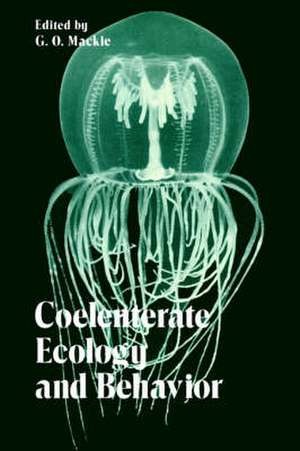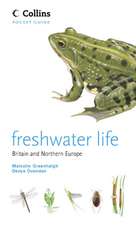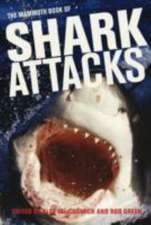Coelenterate Ecology and Behavior
Editat de G.O. Mackieen Limba Engleză Hardback – 30 dec 1976
| Toate formatele și edițiile | Preț | Express |
|---|---|---|
| Paperback (1) | 1247.26 lei 6-8 săpt. | |
| Springer Us – 16 mai 2013 | 1247.26 lei 6-8 săpt. | |
| Hardback (1) | 1245.34 lei 6-8 săpt. | |
| Springer Us – 30 dec 1976 | 1245.34 lei 6-8 săpt. |
Preț: 1245.34 lei
Preț vechi: 1518.71 lei
-18% Nou
Puncte Express: 1868
Preț estimativ în valută:
238.32€ • 258.79$ • 200.19£
238.32€ • 258.79$ • 200.19£
Carte tipărită la comandă
Livrare economică 23 aprilie-07 mai
Preluare comenzi: 021 569.72.76
Specificații
ISBN-13: 9780306309915
ISBN-10: 0306309912
Pagini: 744
Ilustrații: XIV, 744 p.
Dimensiuni: 156 x 234 x 41 mm
Greutate: 1.24 kg
Ediția:1976
Editura: Springer Us
Colecția Springer
Locul publicării:New York, NY, United States
ISBN-10: 0306309912
Pagini: 744
Ilustrații: XIV, 744 p.
Dimensiuni: 156 x 234 x 41 mm
Greutate: 1.24 kg
Ediția:1976
Editura: Springer Us
Colecția Springer
Locul publicării:New York, NY, United States
Public țintă
ResearchDescriere
The study of coelenterates is now one of the most active fields of invertebrate zoology. There are many reasons for this, and not everyone would agree on them, but certain facts stand out fairly clearly. One of them is that many of the people who study coelenterates do so simply because they are interested in the animals for their own sake. This, however, would be true for other invertebrate groups and cannot by itself explain the current boom in coelenterate work. The main reasons for all this activity seem to lie in the considerable concentration of research effort and funding into three broad, general areas of biology: marine ecology, cellular-developmental biology and neurobiology, in all of which coelenterates have a key role to play. They are the dominant organisms, or are involved in an important way, in a variety of marine habitats, of which coral reefs are only one, and this automatically ensures their claims on the attention of ecologists and marine scientists. Secondly, the convenience of hydra and some other hydroids as experimental animals has long made them a natural choice for a variety of studies on growth, nutrition, symbiosis, morphogenesis and sundry aspects of cell biology. Finally, the phylogenetic position of the coelenterates as the lowest metazoans having a nervous system makes them uniquely interesting to those neurobiologists and behaviorists who hope to gain insights into the functioning of higher nervous systems by working up from the lowest level.
Cuprins
Water Flow in the Ecology of Benthic Cnidaria.- The Nature of Flow and the Reaction of Benthic Cnidaria to It.- Mechanical Design in Sea Anemones.- Hydroid Skeletons and Fluid Flow.- The Orientation of Aglaophenia Fans to Current in Laboratory Conditions (Hydrozoa, Coelenterata).- General Ecology of Bottom-Living Forms.- Competitive Interactions and the Species Diversity of Corals.- Habitat-Related Patterns of Productivity of the Foliaceous Reef Coral, Pavona praetorta Dana.- The Ecology of Caribbean Sea Anemones in Panama: Utilization of Space on a Coral Reef.- Growth Interactions Among Morphological Variants of the Coral Acropora palifera.- Settlement, Mortality and Recruitment of a Red Sea Scleractinian Coral Population.- Intraspecific Variability of Zooplankton Feeding in the Hermatypic Coral Montastrea cavernosa.- Accumulation of Dissolved Carbon by the Solitary Coral Balanophyllia elegans — An Alternative Nutritional Pathway?.- Regulation of Frequency of Pedal Laceration in a Sea Anemone.- The Acrorhagial Response in Anthopleura krebsi: Intraspecific and Interspecific Recognition.- Ecological Physiology and Genetics of the Colonizing Actinian Haliplanella luciae.- Nutrition Expérimentale chez les Cérianthaires.- Fouling Community Structure: Effects of the Hydroid, Obelia dichotoma, on Larval Recruitment.- The Zonation of Hydroids Along Salinity Gradients in South Carolina Estuaries.- Responses of Hydra oligactis to Temperature and Feeding Rate.- Biology of Ctenophores, Siphonophores and Medusae.- A Large-Scale Experiment on the Growth and Predation Potential of Ctenophore Populations.- Nutritional Ecology of Agalma okeni (Siphonophora: Physonectae).- Behaviour of Planktonic Coelenterates in Temperature and Salinity Discontinuity Layers.- Craspedacusta sowerbii: An Analysis of an Introduced Species.- Life History of Carybdea alata Reynaud, 1830 (Cubomedusae).- Cubomedusae: Feeding — Functional Morphology, Behaviour and Phylogenetic Position.- An Edwardsiid Larva Parasitic in Mnemiopsis.- Towards a Theory of Speciation in Beroe.- Reproductive Biology.- Sea Anemone Reproduction: Patterns and Adaptive Radiations.- Reproduction of Some Common Hawaiian Reef Corals.- Reproduction, Growth and Some Tolerances of Zoanthus pacificus and Palythoa vestitus in Kaneohe Bay, Hawaii.- Characteristics of Asexual Reproduction in the Sea Anemone, Haliplanella luciae (Verrill), Reared in the Laboratory.- Some Observations on Sexual Reproduction in Tubularia.- The Structure and Function of Centriolar Satellites and Pericentriolar Processes in Cnidarian Sperm.- Early Development and Planula Movement in Haliclystus (Scyphozoa: Stauromedusae).- Larval Dispersal in the Subtidal Hydrocoral Allopora californica Verrill (1866).- Larval Adhesion, Releasing Stimuli and Metamorphosis.- Some Microenvironmental Influences on Attachment Behavior of the Planula of Cyanea capillata (Cnidaria: Scyphozoa).- A New Type of Larval Development in the Actinaria: Giant Larvae. Morphological and Ecological Aspects of Larval Development in Actinostola spetsbergensis.- Stolon vs. Hydranth Determination in Pennaria tiarella Planulae: A Role for DNA Synthesis.- SEM Studies of Strobilating Aurelia.- Associations.- The Quantitative Analysis of the Hydra-Hydramoeba Host-Parasite System.- Aspects of Light in the Biology of Green Hydra.- Survival During Starvation of Symbiotic, Aposymbiotic and Non-Symbiotic Hydra.- Sulfate Utilization in Green Hydra.- Specificity of Symbioses Between Marine Cnidarians and Zooxanthellae.- Macromolecular Mimicry: Substances Released by Sea Anemones and Their Role in the Protection of Anemone Fishes.- Aposematic Coloration and Mutualism in Sponge-Dwelling Tropical Zoanthids.- Skeletal Modification by a Polychaete Annelid in Some Scleractinian Corals.- The Association of Hydractiniid Hydroids and Hermit Crabs, with New Observations from North Florida.- Functional Morphology.- Locomotion in Sea Anemones: The Pedal Disk.- Reflections on Transparency.- A Qualitative and Quantitative Inventory of Nervous Cells in Hydra attenuata Pall.- Evidence for Neural Control of Muscles in Ctenophores.- The Organization of the Neuro-Muscular System of the Diadumene Acontium.- Ultrastructure and Attachment of the Basal Disk of Haliclystus.- The Ultrastructure of the Muscle System of Stomphia coccinea.- Increase in Nematocyst and Spirocyst Discharge in a Sea Anemone in Response to Mechanical Stimulation.- A Comparison of Putative Sensory Receptors Associated with Nematocysts in an Anthozoan and a Scyphozoan.- Behavioral Physiology.- A View of the Evolution of Chemoreceptors Based on Research with Cnidarians.- Chemoreception and Conduction Systems in Sea Anemones.- Interactions Between Conducting Systems in the Sea Anemone Calliactis parasitica.- Slow Conduction in Solitary and Colonial Anthozoa.- An Electrophysiological Analysis of Behavioural Integration in Colonial Anthozoans.- Morphology and Electrophysiology of the Through-Conducting Systems in Pennatulid Coelenterates.- Probable Functions of Bioluminescence in the Pennatulacea (Cnidaria, Anthozoa).- Strategies for the Study of the Coelenterate Brain.- The Control of Fast and Slow Muscle Contractions in the Siphonophore Stem.- The Effect of Electrical Stimulation and Some Drugs on Conducting Systems of the Hydrocoral Millepora complanata.- The Reactions of Hydra attenuata Pall, to Various Photic Stimuli.- Analysis of Hydra Contraction Behaviour.- The Ultrastructural Basis for the Electrical Coordination Between Epithelia of Hydra.- Coordination of Juxtaposed Muscle Layers as Seen in Hydra.- Ionic Requirements of Transepithelial Potentials in Isolated Cell Layers of Hydra.- Electrophysiological Correlates of Feeding Behavior in Tubularia.




